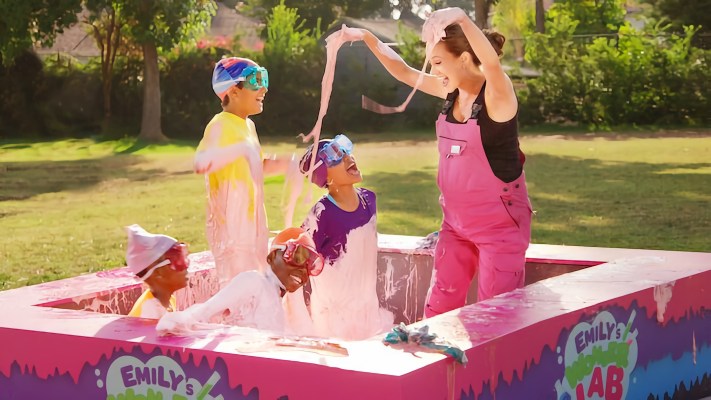Netflix’s children’s programming library continues to grow, and its latest is one of its best original offerings yet — “Emily’s Wonder Lab,” a TV series hosted by engineer, space expert and Emmy-nominated TV science host Emily Calandrelli. The new show’s first season of 10 episodes is now available to stream in its entirety, and each sub-15 minute episode focuses on STEAM topics and experiments that kids can do with their parents at home.
I spoke to Calandrelli (who, I should note, we were lucky enough to have as a past contributor at TechCrunch) about her new show. “Wonder Lab” is the realization of a show concept that she’s been pitching for years, and she explained why the time — and Netflix — was right for it to come to life now.
“I’ve been wanting to bring science to younger kids for a while now,” says Calandrelli, who has hosted “Exploration Outer Space” on Fox for older youth viewers for years. “Netflix recently said that they wanted to work with us, and we developed this concept together with Netflix. It’s all about me being myself — there’s no acting involved. This is me being myself, and kids being their curious selves, and in each episode I do one larger-than-life experiment, and then one at home experiment for the viewers to be able to do with materials they have around their home.”
The episodes are short, but they pack in a lot of information — and even though it’s programming designed for pre-school aged kids, “Emily’s Wonder Lab” doesn’t talk down to kids like you might see in a lot of other programming aimed at the same demographic.
“We do not shy away from the science in the episode — I will always try to put in more science than most TV Hollywood producers will allow,” Calandrelli explained. “Netflix was actually very, very cool with just being like, ‘Yeah, you can, you can talk about anything you want, go ahead.’ As long as we explain it in a way that you don’t need to understand anything coming in, and just explain it in a way that a kid would understand, it made it into the show. I was very thankful, because some of the feedback we had gotten in the past from other networks, who we pitched similar shows to, was that it was just too science-y for their audience — which is frustrating feedback to get when you think that we really need a lot more science appreciation in the next generation.”
Calandrelli also points out that though the timing was coincidental, the show is actually really great as a resource for people doing their best to keep their kids learning, and spending their time in creative pursuits. The show’s format is all about setting up an educational premise, and then providing all the guidance you need to perform an experiment at home that demonstrates the theory at work, using readily available household goods.
While the show came about in part because of Calandrelli’s work on Bill Nye’s Netflix original show “Bill Nye Saves The World,” Calandrelli says that one of the best parts of bringing it to life has been how open Netflix has been to working with her vision. That’s a markedly different experience from what she encountered when shopping earlier versions of the show around to other networks, she says.
“In previous pitch meetings with large science networks, I’ve often gotten the feedback that the people who watch science shows are predominantly male,” she told me. “So in these pitch meetings, the feedback I often get is, unfortunately, ‘Our audience is primarily male, and so they won’t be able to relate to a female host’ — that’s the reason that I’m given for why they don’t want my show. So to have a platform like Netflix be excited to have a female host a science show on their network really feels like a win.”
